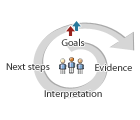A Framework for Formative Assessment in the Inquiry Project
Formative Assessment
Example of formative assessment
When you see the icon to the right in the Plan section of an investigation and click the blue text, it will take you to an example of formative assessment occurring within that investigation.

Formative Assessment Framework Icon
The icon to the left reflects the formative assessment framework, a series of stages in a cycle: learning goal ->gathering evidence ->interpretation of the evidence -> next steps that lead to a new goal.
Formative assessments always begin with a clear learning goal. The goal may be expressed as a question, for example, Do students understand that when a ball of plastic modeling clay is reshaped, the weight and volume will stay the same? Goals may address science content or the inquiry process. The teacher then collects evidence of students' progress towards the goal. In the classroom, there are three sources of evidence: what students say as they discuss their work, what they do as they carry out first-hand investigations, and what they write or draw. Based on a set of criteria, the teacher interprets and appraises what she sees or hears, and decides what next steps will help students make further progress towards the goal. Then, she sets a new goal and another formative assessment cycle begins.
You'll see three figures in the center of the icon. These are students who need to be partners in the formative assessment process for it to be fully effective. They need to be clear about the learning goals and aware of the kind of evidence they can provide to demonstrate their understanding. They can be expected to take increasing responsibility for interpreting their work and be able to answer the question What next steps might I take to strengthen my work?
Formative Assessment Examples in the Inquiry Curriculum
Grade 3
- 1. Materials: Investigation 1
- 1. Materials: Investigation 4
- 2. Weight: Investigation 1
- 2. Weight: Investigation 4
- 3. Standard Measures: Investigation 2
- 3. Standard Measures: Investigation 3
- 4. Volume: Investigation 2
- 4. Volume: Investigation 3
Grade 5
Grade 4
- 1. Under Foot: Investigation 1.3
- 1. Under Foot: Investigation 1.4
- 2. Heavy for Size: Investigation 2.2
- 2. Heavy for Size: Investigation 2.3
- 3. Liquid Materials: Investigation 3.1
- 3. Liquid Materials: Investigation 3.3
- 4. Mineral Materials: Investigation 4.1
- 4. Mineral Materials: Investigation 4.2
- 5. Transformations: Investigation 5.1
- 5. Transformations: Investigation 5.2



